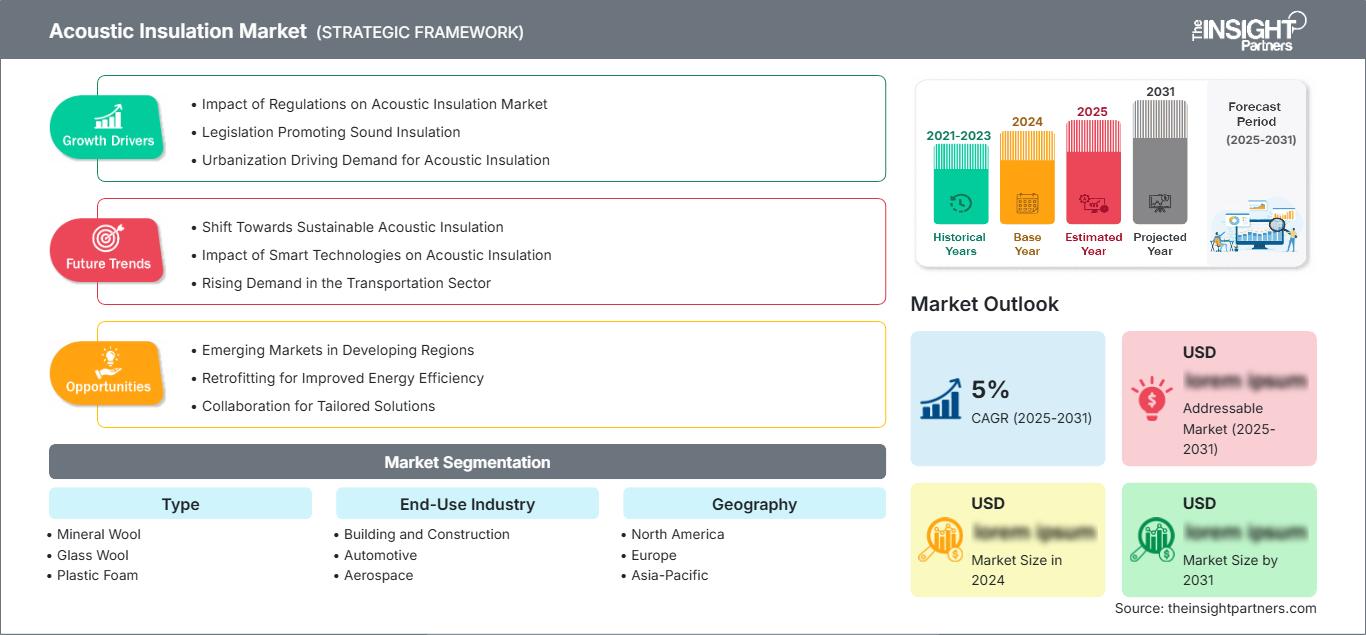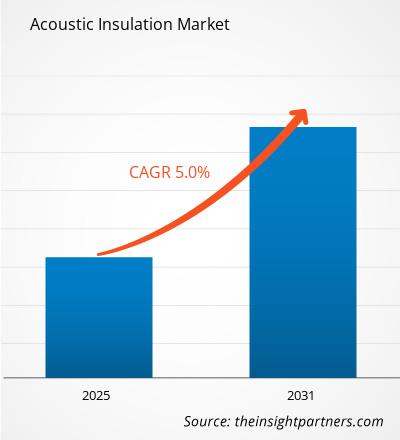Le marché de l'isolation acoustique devrait atteindre 22,68 milliards de dollars américains d'ici 2031. Il devrait enregistrer un TCAC de 4,8 % entre 2025 et 2031.
Le rapport sur le marché de l'isolation acoustique est segmenté par type (laine minérale, laine de verre, mousse plastique, mousse élastomère et autres) et par secteur d'utilisation finale (bâtiment et construction, automobile, aérospatiale, pétrole et gaz, production d'énergie et autres). L'analyse mondiale est ensuite détaillée au niveau régional et par principaux pays. La taille du marché et les prévisions aux niveaux mondial, régional et national pour tous les segments clés sont incluses dans le rapport. Les valeurs sont exprimées en dollars américains pour l'analyse, les segments, les régions et les pays. Le rapport couvre les tendances et la dynamique du marché, notamment les moteurs, les freins et les principales opportunités. Le rapport couvre également le paysage industriel et l'analyse concurrentielle, notamment la concentration du marché, une analyse par cartographie des facteurs clés, les principaux acteurs et les développements récents du marché.
Objectif du rapport
Le rapport sur le marché de l'isolation acoustique, réalisé par The Insight Partners, vise à décrire le paysage actuel et la croissance future, les principaux facteurs de croissance, les défis et les opportunités. Il fournira des informations précieuses à divers acteurs du secteur, tels que :
- Fournisseurs de technologies/Fabricants : Pour comprendre l'évolution de la dynamique du marché et identifier les opportunités de croissance potentielles, afin de prendre des décisions stratégiques éclairées.
- Investisseurs : Pour réaliser une analyse approfondie des tendances concernant le taux de croissance du marché, les projections financières et les opportunités tout au long de la chaîne de valeur.
- Organismes de réglementation : Pour encadrer les politiques et les activités du marché afin de minimiser les abus, préserver la confiance des investisseurs et garantir l'intégrité et la stabilité du marché.
Segmentation du marché de l'isolation acoustique : Type
- Laine minérale
- Laine de verre
- Mousse plastique
- Mousse élastomère
Secteurs d'utilisation finale
- Bâtiment et construction
- Automobile
- Aérospatiale
- Pétrole et gaz
- Production d'énergie
Vous bénéficierez d’une personnalisation sur n’importe quel rapport - gratuitement - y compris des parties de ce rapport, ou une analyse au niveau du pays, un pack de données Excel, ainsi que de profiter d’offres exceptionnelles et de réductions pour les start-ups et les universités
Marché de l'isolation acoustique: Perspectives stratégiques

- Obtenez les principales tendances clés du marché de ce rapport.Cet échantillon GRATUIT comprendra une analyse de données, allant des tendances du marché aux estimations et prévisions.
Facteurs de croissance du marché de l'isolation acoustique
- Impact de la réglementation sur le marché de l'isolation acoustique : Le secteur mondial du bâtiment et de la construction a vu se renforcer les réglementations, notamment les politiques, dans tous les pays, en raison de la nécessité d'améliorer l'isolation acoustique des bâtiments. Par exemple, de nombreux pays ont imposé des normes de performance acoustique aux constructeurs et aux bâtiments, en particulier dans les régions bruyantes ces dernières années.
- Législation favorisant l'isolation acoustique : La législation améliore la qualité de vie des populations et permet aux architectes et aux promoteurs d'utiliser des matériaux d'isolation acoustique performants, créant ainsi un marché pour ces matériaux.
- L'urbanisation, moteur de la demande d'isolation acoustique : L'un des facteurs qui a accéléré la croissance du marché de l'isolation acoustique est l'urbanisation rapide, notamment dans de nombreux pays du monde. L'exode rural s'accompagne d'une offre accrue de logements, d'espaces de bureaux et d'autres services publics. Par conséquent, l'augmentation des activités de construction a entraîné une forte hausse de l'utilisation des matériaux et procédés d'insonorisation.
Tendances futures du marché de l'isolation acoustique
- Vers une isolation acoustique durable : Le marché de l'isolation acoustique connaît des transformations profondes, les tendances du secteur s'orientant vers l'utilisation de matériaux durables et écologiques. Face à la préoccupation croissante des consommateurs et des entreprises pour l'environnement, les fabricants commencent à envisager l'utilisation de matériaux recyclés et écologiques dans la fabrication de produits acoustiques.
- Impact des technologies intelligentes sur l'isolation acoustique : Le développement des technologies intelligentes dans la conception des bâtiments va révolutionner l'isolation acoustique. Les capteurs intelligents et autres systèmes peuvent contrôler instantanément le bruit à l'intérieur des bâtiments et modifier les systèmes d'insonorisation en fonction des besoins.
- Demande croissante dans le secteur des transports : Le secteur des transports devrait également connaître une utilisation accrue des matériaux d'isolation acoustique, notamment en raison de l'essor des véhicules électriques et de la reprise des transports en commun. En outre, les secteurs ferroviaire et aérien investissent également dans des systèmes de contrôle du bruit haut de gamme afin de réduire les nuisances sonores, créant ainsi des opportunités pour de nouveaux fournisseurs de produits d'isolation acoustique.
Opportunités du marché de l'isolation acoustique
- Marchés émergents dans les régions en développement : Le secteur de la construction dans les pays en développement, notamment en Asie-Pacifique et en Afrique, représente un marché clé pour les acteurs de l'isolation acoustique. Cette croissance est due aux plans de développement des infrastructures mis en œuvre dans ces régions, ainsi qu'à l'urbanisation. Le marché de l'isolation acoustique devrait donc connaître une croissance significative.
- Rénovation pour une meilleure efficacité énergétique : La rénovation des bâtiments existants pour une meilleure efficacité énergétique est une priorité croissante, offrant ainsi un potentiel important aux produits d'isolation acoustique. La plupart des particuliers et des entreprises cherchant à améliorer leurs biens immobiliers, l'installation de systèmes acoustiques permettra non seulement d'augmenter leur valeur, mais aussi d'accroître leur attractivité.
- Collaboration pour des solutions sur mesure : La coopération entre constructeurs, architectes et fabricants peut permettre d’améliorer l’offre de produits d’isolation acoustique. Proposer des solutions spécifiques pour des problèmes acoustiques spécifiques dans différents environnements (résidentiel, commercial et industriel) peut ouvrir de nouveaux marchés et constituer un avantage concurrentiel.
Marché de l'isolation acoustique
Les analystes de The Insight Partners ont analysé en détail les tendances régionales et les facteurs influençant le marché de l'isolation acoustique tout au long de la période prévisionnelle. Cette section aborde également les segments et la répartition géographique du marché de la gestion des troubles du rythme cardiaque en Amérique du Nord, en Europe, en Asie-Pacifique, au Moyen-Orient et en Afrique, ainsi qu'en Amérique du Sud et centrale.
Portée du rapport sur le marché de l'isolation acoustique
| Attribut de rapport | Détails |
|---|---|
| Taille du marché en 2024 | US$ XX Billion |
| Taille du marché par 2031 | US$ 22.68 Billion |
| TCAC mondial (2025 - 2031) | 4.8% |
| Données historiques | 2021-2023 |
| Période de prévision | 2025-2031 |
| Segments couverts |
By Type
|
| Régions et pays couverts | Amérique du Nord
|
| Leaders du marché et profils d'entreprises clés |
|
Densité des acteurs du marché de l'isolation acoustique : comprendre son impact sur la dynamique commerciale
Le marché de l'isolation acoustique connaît une croissance rapide, portée par une demande croissante des utilisateurs finaux, elle-même alimentée par l'évolution des préférences des consommateurs, les progrès technologiques et une meilleure connaissance des avantages du produit. Face à cette demande grandissante, les entreprises élargissent leur offre, innovent pour répondre aux besoins des consommateurs et tirent parti des tendances émergentes, ce qui stimule davantage la croissance du marché.

- Obtenez le Marché de l'isolation acoustique Aperçu des principaux acteurs clés
Points clés de vente
- Couverture exhaustive : Ce rapport analyse en détail les produits, services, types et utilisateurs finaux du marché de l’isolation acoustique, offrant ainsi une vision globale.
- Analyse d’experts : Ce rapport repose sur l’expertise approfondie d’analystes et de spécialistes du secteur.
- Informations actualisées : Grâce à sa couverture des informations et tendances les plus récentes, ce rapport garantit la pertinence de vos analyses.
- Options de personnalisation : Ce rapport peut être personnalisé pour répondre aux besoins spécifiques de chaque client et s’adapter parfaitement à ses stratégies commerciales.
Ce rapport d’étude de marché sur l’isolation acoustique vous permettra ainsi de mieux comprendre le contexte sectoriel et les perspectives de croissance. Malgré quelques points à améliorer, les avantages de ce rapport l’emportent généralement sur les inconvénients.
- Analyse historique (2 ans), année de base, prévision (7 ans) avec TCAC
- Analyse PEST et SWOT
- Taille du marché Valeur / Volume - Mondial, Régional, Pays
- Industrie et paysage concurrentiel
- Ensemble de données Excel
Rapports récents
Rapports connexes
Témoignages
Raison d'acheter
- Prise de décision éclairée
- Compréhension de la dynamique du marché
- Analyse concurrentielle
- Connaissances clients
- Prévisions de marché
- Atténuation des risques
- Planification stratégique
- Justification des investissements
- Identification des marchés émergents
- Amélioration des stratégies marketing
- Amélioration de l'efficacité opérationnelle
- Alignement sur les tendances réglementaires




















 Obtenez un échantillon gratuit pour - Marché de l'isolation acoustique
Obtenez un échantillon gratuit pour - Marché de l'isolation acoustique